Sandy Island Accessible Exploration
Explore the Seafloor
Come and explore Sandy Island! Learn about herring fishing in the Bay of Fundy. Then come for a dive at Sandy Island’s abandoned weir. Let images and videos introduce you to some of the amazing species that live here.-
Weir Fishing 1
This is Sandy Island Weir. People use weirs to capture herring. In Atlantic Canada, brush weirs were initially used by First Nations people. White settlers also began to use brush weirs in New Brunswick around 1920. In modern weirs, the brush has been replaced by netting made from synthetic twine. At the height of the fishery, there were over 400 weirs operating in the Bay of Fundy. Since the 1970s, the herring catch has declined, and many of the weirs are no longer used.
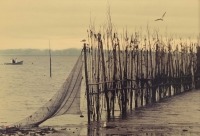
(Photo: Photographer unknown, provided by Fisheries and Oceans Canada)

-
Weir Fishing 2
Weirs take advantage of the natural behaviour of herring. Herring tend to move to the surface and inshore at night. People place weirs in shallow coastal water. Most weirs have a long wing, a fence-like structure that directs the herring into the weir mouth. The herring travel through the mouth of the weir into the parlour. Once inside, the curve of the fence directs the fish away from the entrance and they swim in a figure eight pattern, captured in the weir. Video Description: From the air, we see different weirs in the Western Isles. A large doubled parloured weir sits between two islands. Another has a long wing that extends onto an island's sandy beach. There is a cluster of small weirs. This video has no sound.
-
Weir Fishing 3
Video Description: Once the herring are trapped in the weir, the fishermen use a seine net to catch them. The fishermen are inside the weir in a small white boat. They drop the seine net overboard while moving the boat forward. Lead weights hold the bottom of the net to the seabed, and floats hold the top at the surface. Once the fishermen have laid the net all around the weir, they pull the purse strings tight to close the bottom of the net, trapping the herring inside. A carrier boat comes into the weir to collect the herring. It pumps them out of the seine net and into its hold. Video Transcript
-
Sandy Island
Here we stand on the southern end of Sandy Island, looking toward the north. You can see the remains of the weir pilings on the sandy beach. The south end of the island is rocky and exposed to strong tidal currents. Spruce Island shelters the eastern side. The seabed around the weir is sand and mud.
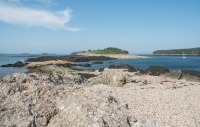
(Photo: Claire Goodwin)

-
Diver and Weir Piling
The Huntsman’s research vessel the Fundy Spray stands by as the research dive team surfaces from exploring the weir.
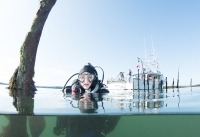
(Photo: Claire Goodwin/HMSC)

-
Sea Vase Seasquirts
Sea vases cover every inch of this area of weir piling. This sea squirt is a species not native to Canada. It came from Europe and arrived in New Brunswick in 1852. It has become abundant in the Bay of Fundy and scientists consider it invasive. It can grow, reproduce, and spread quickly. It can smother native species and competes with them for food.View species
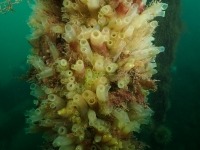
(Photo: Claire Goodwin/HMSC)

-
Diver and Burrowing Anemone
Northern cerianthid burrowing anemones are common in the muddy sediments of the sheltered waters around the weir. They are difficult to approach without stirring up the silt! These anemones can be very large, reaching over 20 centimetres in diameter. If disturbed, they can rapidly retract into their long tube, which extends down into the mud.View species
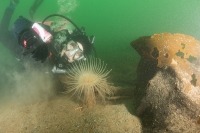
(Photo: Claire Goodwin)

-
Lobster
Scientists have recently shown that juvenile lobsters settle and live on mud seabeds as well as rocky habitats. They create burrows and take shelter in them to protect themselves from predators. During winter, adult lobster may also take shelter in a mud burrow. They close off the entrance with sediment and debris and may stay in the burrow for weeks or months at a time.View species
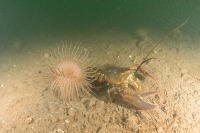
(Photo: Claire Goodwin)

-
Hermit Crab
Sea slugs can be very fussy eaters. This sea slug, Cuthona nana, only eats the snail fur hydroid. In turn, the hydroid is picky about where it grows: usually on the shells of hermit crabs. Hydroids can't move by themselves, so living on the back of a crab gives them some chance of escaping their sea slug predators. It also allows them access to more food. The hermit crab gets some benefit from its hitchhikers as well: the hydroid deters predators from eating it. The hydroid also makes the effective size of the shell larger so the hermit crab has to change shells less often. Scientists have shown that hermit crabs select hydroid-covered shells over bare ones even when the hydroid-covered ones are too small for them.View species
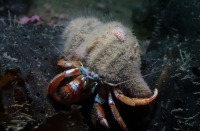
(Photo: Connie Bishop)

-
Weir Piling
The pilings of the abandoned weir are covered in life. This piling has many green urchins and a turf of seaweed and hydroids.
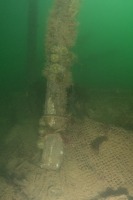
(Photo: Claire Goodwin)

-
Sandy Island Notch
Dense octocoral patches are relatively rare in the Quoddy region. This species has crawling larvae that don't travel far from their parents. This makes it difficult for them to colonize new areas. Video Description: The seabed at the end of Sandy Island is very different from the sheltered areas around the weir. This site is situated in the gap between Sandy Island and the rocks at its tip, and is known as the “Notch.” Here strong currents sweep the rocky seabed, providing lots of food for filter-feeding animals. We hear the diver breathing as they scan the camera along the underwater cliff. The rock is densely covered in many different animals: large yellow sheep's tongue sponges, sea potato sea squirts, and octocorals.
-
Burrowing Anemone Video
Video Description: We see two large white northern cerianthid anemones from the side. Their long tubes reach down into the muddy seabed. Their tentacles stretch upward into the green water to catch particles that we can see drifting past us in the slight current. We can hear a relaxing, gentle, tinkle of bubbles as the cameraman exhales. The camera moves on to look at a group of three anemones from above. We then zoom in and watch the striped tentacles delicately coil as they reach down to the anemone’s mouth.View species
-
Red Hake
Juvenile hake are often found in or under live scallops or scallop shells. They may also be found hiding under shells, sponges, and rocks, and here an anemone. It is thought that this behaviour is critical in protecting them from predators. Video Description: A juvenile red hake rests on the muddy seabed, next to a northern cerianthid anemone. It turns and tucks itself under the anemone’s tentacles. It gently fans its pectoral fins to maintain position. We can hear the bubbles of the cameraman’s exhalations. We zoom out to see the anemone above it.View species
-
Pollock Shoal
Pollock shoals are usually composed of fish of similar size. Young fish (0-2 years old) are mainly found in shallow waters inshore, including rocky subtidal and intertidal zones. Older fish move into deeper water and out to offshore banks. Video Description: At the rocky end of Sandy Island we encounter a school of pollock. Hundreds of fish weave through the green water. Their sides glinting silver in the sunlight. A large cunner slowly swims past us. We can hear the exhalations of the camerawoman and the thrum of the boat engine above us.View species

